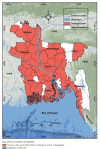The One Health Epidemiology of Avian Influenza Infection in Bangladesh: Lessons Learned from the Past 15 Years
- PMID: 40303708
- PMCID: PMC12017047
- DOI: 10.1155/2023/6981327
The One Health Epidemiology of Avian Influenza Infection in Bangladesh: Lessons Learned from the Past 15 Years
Abstract
Avian influenza viruses (AIVs) are significant transboundary zoonotic pathogens that concern both animal and human. Since the first report of H5N1 AIV in Bangladesh in early 2007, it resulted in numerous outbreaks across the country, hindering the sustainable growth of the poultry industry through economic losses in different production systems (commercial and backyard). Highly pathogenic avian influenza (HPAI) virus and low pathogenic avian influenza (LPAI) virus are currently cocirculating and causing infection in poultry sectors in an endemic manner in Bangladesh as well as in wild bird species. The introduction of multiple clades of H5N1 in different poultry species and the reassortment of AIVs with different patterns of infections have complicated the epidemiological situation for control and created conditions to increase the virulence of the virus, host range, and potential zoonotic transmission. The risk of viral transmission at the human-poultry interface is increasing over time due to inadequate surveillance and early detection strategies and practices, ineffective biosecurity practices among poultry raisers, and the complex supply chains of backyard and commercial poultry and live bird market (LBM) systems. Improving AIV surveillance in poultry flocks and LBMs, vaccination, biosecurity, and awareness among poultry professionals is beneficial to controlling the disease burden in the poultry sector. However, human cases of AIV related to poultry production and marketing chain in Bangladesh suggest a One Health approach engaging various stakeholders from the public and private would be a better option for successfully controlling avian influenza outbreaks in Bangladesh. This review of literature presents the comprehensive overview of AIV infection status in Bangladesh, including a description of pathways for zoonotic transmission at different epidemiological interfaces, the genetic evolution of the virus, and the need for improvement of disease control strategies incorporated with early detection, application of effective vaccines, increases the proper biosecurity practices and improvement of awareness among the poultry raisers, traders and consumers using a One Health approach.
Copyright © 2023 Mohammad Mahmudul Hassan et al.
Conflict of interest statement
The authors declare that they have no conflicts of interest.
Figures




Similar articles
-
Controlling Avian Influenza Virus in Bangladesh: Challenges and Recommendations.Viruses. 2020 Jul 12;12(7):751. doi: 10.3390/v12070751. Viruses. 2020. PMID: 32664683 Free PMC article. Review.
-
Review analysis and impact of co-circulating H5N1 and H9N2 avian influenza viruses in Bangladesh.Epidemiol Infect. 2018 Jul;146(10):1259-1266. doi: 10.1017/S0950268818001292. Epub 2018 May 21. Epidemiol Infect. 2018. PMID: 29781424 Free PMC article.
-
Risk-based surveillance for avian influenza control along poultry market chains in South China: The value of social network analysis.Prev Vet Med. 2011 Dec 1;102(3):196-205. doi: 10.1016/j.prevetmed.2011.07.007. Epub 2011 Sep 16. Prev Vet Med. 2011. PMID: 21925753 Free PMC article.
-
Comprehensive Insights into Highly Pathogenic Avian Influenza H5N1 in Dairy Cattle: Transmission Dynamics, Milk-Borne Risks, Public Health Implications, Biosecurity Recommendations, and One Health Strategies for Outbreak Control.Pathogens. 2025 Mar 13;14(3):278. doi: 10.3390/pathogens14030278. Pathogens. 2025. PMID: 40137763 Free PMC article. Review.
-
India's public health risk from the emerging zoonotic bird flu (H5N1) transmission from backyard flock: a call for people-centric actions for improved sustainable development goals.Trop Anim Health Prod. 2025 Jun 30;57(6):291. doi: 10.1007/s11250-025-04534-0. Trop Anim Health Prod. 2025. PMID: 40586924 Review.
References
-
- Chakma D., Rushton J. Rapid assessment on socio-economic impact due to highly pathogenic avian influenza in Bangladesh. 2008. Report submitted to FAO 35.
Publication types
MeSH terms
LinkOut - more resources
Full Text Sources
Medical
Miscellaneous

